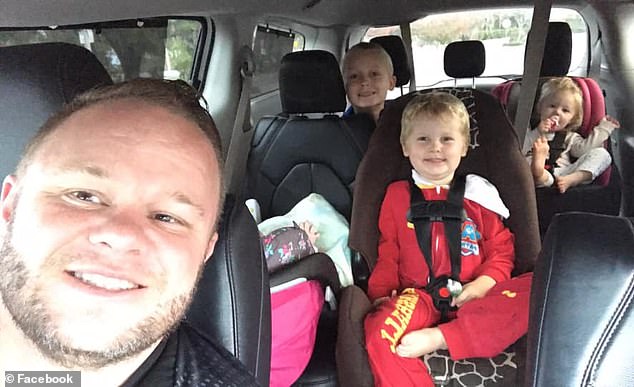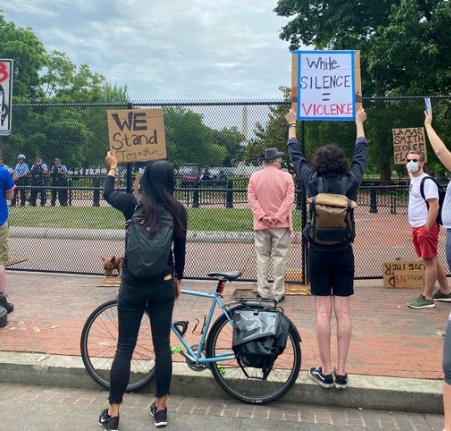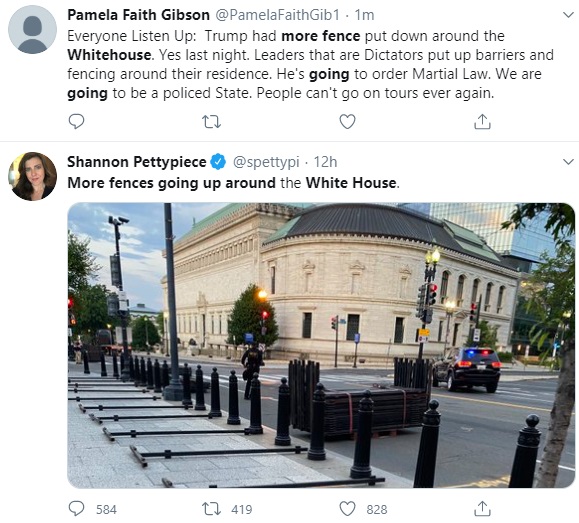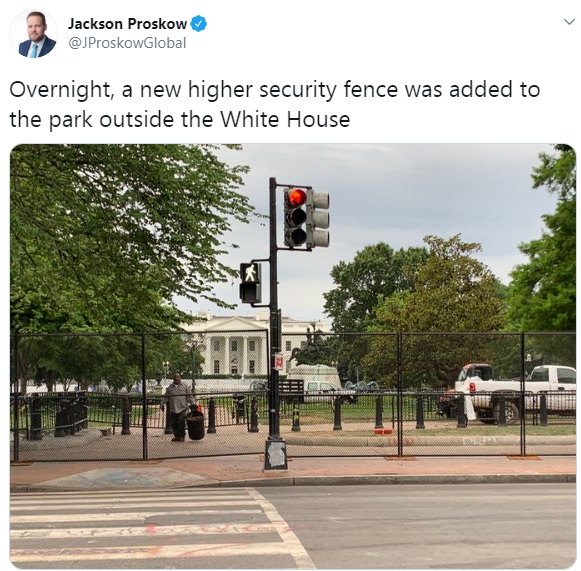Fence perimeter around the White House today

USA & CANADA (901)
Latest News
Unbelievable! Man Kills His Wife And 4 Children Then Stores Their Bodies At Home For 6 Weeks
Sunday, 07 June 2020 23:41 Written by dailymailTrump Builds Fence Around White House Following Protests (Video)
Sunday, 07 June 2020 23:25 Written by toriEXCLUSIVE: U.S. asked Buruji Kashamu to provide evidence on 9/11 attacks
Sunday, 07 June 2020 02:54 Written by PREMIUM TIMESWhile he was in jail in the United Kingdom contesting a request by United States authorities to have him extradited to face drug trafficking charges, Buruji Kashamu, a former senator who represented Ogun East District, obtained information about the 9/11 attacks and tried to pass it over to the U.S. government, court documents recently obtained by PREMIUM TIMES have revealed.
The September 11, 2001 attacks were a series of coordinated attacks by terrorists who flew hijacked planes into the World Trade Centre in New York, the Pentagon in Arlington County, Virginia, and into a field, a near Shanksville, Pennsylvania. The attacks, which the U.S. government said were carried out by the Osama bin Laden-led group, Al Qaeda, killed nearly 3,000 people and left 25,000 others injured.
On December 18, 1998, the UK’s Metropolitan Police arrested Mr Kashamu, who was travelling with a Benin passport. Police found $230,000 in cash in Mr Kashamu’s possession. Meanwhile, he had seven months earlier been indicted by a grand jury for conspiracy to import heroin into the U.S.
Mr Kashamu was indicted following incriminating evidence provided by three of his alleged co-conspirators. They alleged that the man they said was also known as “Alaji” or “God” was the leader of the heroin smuggling ring. Mr Kashamu was detained at the Brixton Prison pending the completion of his extradition process which had been initiated by the United States’ Department of Justice’s Office of International Affairs.
Mr Kashamu says he was not the leader of the drug-smuggling conspiracy. He has claimed that the so-called “Alaji”, the drug-smuggling kingpin was his brother, Adewale Kashamu, who was allegedly killed in 1989 by the personnel of the Nigerian Customs. He says he shared a striking resemblance with his deceased brother.
On January 10, 2003, Timothy Workman, a magistrate in the UK, dismissed the extradition request put forward by the United States, stating among other things that Mr Kashamu indeed had a similar-looking brother who was killed in 1989 by Customs officials. The Magistrate also found that certain assertions by the U.S. government in the extradition proceedings were untrue. He subsequently ordered the release of Mr Kashamu.
However, the United States has not relented in its quest in extraditing Mr Kashamu to the U.S. to face trial for the alleged heroin-smuggling conspiracy he led. It argued that it is not bound by Mr Workman’s conclusion that Mr Kashamu’s brother was the co-conspirator because “Kashamu’s extradition proceeding was a preliminary proceeding and not a proceeding in which the full merits, and the full evidence, were considered.”
“Magistrate Workman himself recognized that this Court and the jury were the ultimate determiners of the credibility of the witnesses, including on the issue of Kashamu’s identification as the leader of the heroin smuggling conspiracy, and that his decision was limited to the matter before him,” it stated in its response to a 2009 application by Mr Kashamu at a United States District Court Northern District of Illinois Eastern Division.
The U.S. government said “The government believes in good faith that Kashamu, and not any alleged brother, is the co-conspirator in this case” because two members of the Kashamu’s alleged heroin-smuggling ring, Catherine and Ellen Wolters, “independently identified Kashamu, through his arrest photograph, as the person whom they knew as “Alaji.” The government, to the undersigned attorney’s knowledge, has never received any photograph of the alleged brother and has been unable to test the veracity of Kashamu’s claim about him.”
As recent as 2015, the U.S. government attempted to extradite Mr Kashamu using the National Drug Law Enforcement Agency (NDLEA) but the attempt was aborted by an order of a Federal High Court in Abuja.
Kashamu offers to provide information about 9/11 attacks
According to an affidavit he swore to on February 2, 2009, Mr Kashamu said while he was being held in prison, he shared a cell with a “Muslim radical” who told him that there were plans to bomb the United States.
“I informed my Chicago lawyer, Thomas Durkin, of this information and he informed the appropriate authorities. We received no response,” he wrote.
He added that after the 9/11 bombings he was contacted by a United States Attorney, Patrick Fitzgerald, to provide details of what he had been told by his cellmate.
“I was told that if I pleaded guilty to the case (heroin smuggling) and provided information that I knew regarding the bombing of the World Trade Centre, I could receive a favourable plea bargain. I could not accept the offer because I am not guilty of the case,” he wrote.
A handwritten letter by S.J Humphrys, an officer at the Brixton prison written on December 30, 2001, also confirmed that Mr Kashamu met officers from Scotland Yard, the headquarters of the Metropolitan Police, in respect of the said information he was told about the 9/11 attacks.
“I can confirm that D.S Andy Weld and D.C Richard Jordan from Scotland Yard (SO12 anti-terrorist Squad) came to see Mr Kashamu on 28/9/2001 and spoke at length with me present with regard to the horrific events of September 11th in New York. The meeting concluded with Mr Kashamu handing over approximately three pages of topical terrorist information,” he wrote.
“The two SO I2 officers returned at a later date collecting a further seven pages of additional terrorist information. The two officers finally came on 6/11/2001 for a further meeting with Mr Kashamu, they thank(ed) Mr Kashamu for the information and I stated it was extremely useful they then continue to ask about terrorists living in London who were linking with a terrorist that had been arrested in Washington.
“They further stated that the U.S government were requesting that Mr Kashamu would continue to give further evidence against those terrorists in a US court. In concluding this …meeting they confirmed that the US government found the information extremely valuable.
“I can once again confirm that all those information was handed over with me present as a witness to the above proceedings,” he wrote.
On August 21, 2002, in response to a request by Mr Kashamu, his U.S. lawyer, Mr Durkin, wrote a letter to Mr Kashamu about his offer to cooperate with the United States authorities “regarding information you might have with respect to activities of interest to them.”
Mr Durkin stated that his record showed that later in March 2001 he had several conversations with Mr Fitzgerald regarding information connected to the World Trade Centre bombing case.
“My record also reflected the fact that on September 21, 2001, I received on your behalf a “proffer” letter from the U.S Attorney’s Office for the Northern District of Illinois regarding the terms of a meeting you were to have with the US agents regarding potential information concerning the attacks which occurred in New York and Virginia on September 11, 2001. This meeting took place at Brixton on October 2, 2001.
“At the meeting, Patrick Blegen of our firm forwarded eleven pages of documents to Special Agent Joe hummer of the Federal Bureau of Investigation. Copies of these documents were sent by facimile to me by Assistant U.S Attorney Diane MacArthur on October 3, 2001. I have maintained copies of these documents in our files, and at your request copies were forwarded to you by one of our assistants on May 22, 2002,” he wrote.
U.S. promises not to use Kashamu’s testimony against him
On September 21, 2001, Mr Fitzgerald wrote Mr Durkin about the said information his client (Mr Kashamu) offered to share with US authorities.
“As you have discussed with Assistant United States Attorney Diane MacArthur, the government is conducting an investigation into the attacks which occurred at the World Trade Centre in New York City and the Pentagon Building in Virginia on September 11, 2001.
“Of course, the government welcomes any information that may aid it in reaching a proper determination of the matter. Accordingly, the government seeks a proffer of the testimony of your client, Buruji Kashamu, regarding his knowledge of the facts underlying this matter.”
He explained that the U.S. government required that the statement to be given by Mr. Kashamu should be “completely truthful” while adding that “anything revealed to the government by you or your client, during the proffer cannot and will not be used against your client, Buruji Kashamu, in the government’s case-in-chief at trial, in the extradition proceeding pending against Kashamu… or in aggravation of your client’s sentence, in accordance with sentencing guideline 202.8.”
Contrary to My Kashamu’s claim in his affidavit that he was offered to provide the information for an offer of a plea bargain, which will lead to a reduced sentence, Mr Fitzgerald stated that the government is “completely free to pursue any and all investigative (illegible word) derived in any way from the proffer, which could result in the requisition of evidence admissible against your client.”
“Furthermore, if your client should subsequently testify contrary to the substance of the proffer, or otherwise present a position inconsistent with the proffer at sentencing for any purpose, nothing shall prevent the government from using the substance of the proffer at sentencing for the purpose, at a trial for impeachment or in rebuttal testimony, in a prosecution for perjury, or in this pending extradition proceeding.”
The letter did not say anything about a plea bargain leading to a reduction of jail term upon sentencing.
Why I Hid Inside White House Underground Bunker During Protest - Trump
Sunday, 07 June 2020 00:56 Written by toriPopular News
As Minneapolis burns, Trump's presidency is sinking deeper into crisis. And yet, he may still be re-elected
Thursday, 04 June 2020 12:11 Written by theconversation 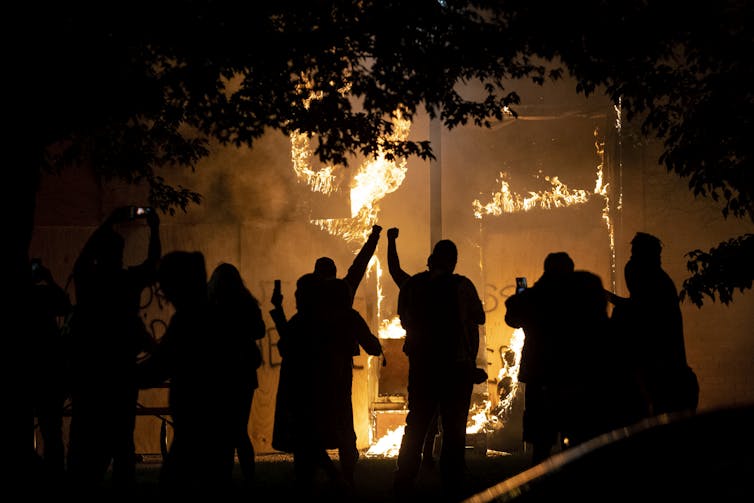
Timothy J. Lynch, University of Melbourne
Violence has erupted across several US cities after the death of a black man, George Floyd, who was shown on video gasping for breath as a white police officer, Derek Chauvin, knelt on his neck. The unrest poses serious challenges for President Donald Trump and former Vice President Joe Biden as each man readies his campaign for the November 3 election.
If the coronavirus had not already posed a threat to civil discourse in the US, the latest flashpoint in American racial politics makes this presidential campaign potentially one of the most incendiary in history.
COVID-19 and Minneapolis may very well form the nexus within which the 2020 campaign will unfold. Trump’s critics have assailed his handling of both and questioned whether he can effectively lead the country in a moment of crisis.
And yet, he may not be any more vulnerable heading into the election.
A presidency in crisis?
As the incumbent, Trump certainly faces the most immediate challenges. Not since Franklin Roosevelt in the second world war has a US president presided over the deaths of so many Americans from a single cause.
The Axis powers and COVID-19 are not analogous, but any presidency is judged by its capacity to respond to enemies like these. With pandemic deaths now surpassing 100,000, Trump’s fortunes will be inexorably tied to this staggering (and still rising) figure.
Worse, the Minneapolis protests are showing how an already precarious social fabric has been frayed by the COVID-19 lockdowns.
Read more: Donald Trump blames everyone but himself for the coronavirus crisis. Will voters agree?
Americans have not come together to fight the virus. Rather, they have allowed a public health disaster to deepen divisions along racial, economic, sectional and ideological lines.
Trump has, of course, often sought to gain from such divisions. But the magnitude and severity of the twin crises he is now facing will make this very difficult. By numerous measures, his is a presidency in crisis.
And yet.
Trump, a ferocious campaigner, will try to find ways to use both tragedies to his advantage and, importantly, makes things worse for his challenger.
For starters, Trump did not cause coronavirus. And he will continue to insist that his great geo-strategic adversary, the Chinese Communist Party, did.
And his is not the first presidency to be marked by the conflagration of several US cities.
Before Minneapolis, Detroit (1967), Los Angeles (1992) and Ferguson, Missouri (2014) were all the scenes of angry protests and riots over racial tensions that still haven’t healed.
And in the 19th century, 750,000 Americans were killed in a civil war that was fought over whether the enslavement of African-Americans was constitutional.
Trump may not have healed racial tensions in the US during his presidency. But, like coronavirus, he did not cause them.
How Trump can blame Democrats for Minneapolis
Not unhappily for Trump, Minneapolis is a largely Democratic city in a reliably blue state. He will campaign now on the failure of Democratic state leaders to answer the needs of black voters.
Trump will claim that decades of Democratic policies in Minnesota – including the eight years of the Obama administration – have caused Minneapolis to be one of the most racially unequal cities in the nation.
In 2016, Trump
whether Democratic leaders have done anything to improve their lives.What do you have to lose by trying something new, like Trump?
He will repeat this mantra in the coming months.
It also certainly helps that his support among Republican voters has never wavered, no matter how shocking his behaviour.
He has enjoyed a stable 80% approval rating with GOP voters throughout the coronavirus crisis. This has helped keep his approval rating among all voters steady as the pandemic has worsened, hovering between 40 and 50%.
These are not terrible numbers. Yes, Trump’s leadership has contributed to a series of disasters. But if the polls are correct, he has so far avoided the kinds of catastrophe that could imperil his chances of re-election.
Read more: In Trump we trust: why continual disasters fail to shake the president's loyalists
Why this moment is challenging for Biden
Biden should be able to make a good case to the American people at this moment that he is the more effective leader.
But this has not yet been reflected in polls, most of which continue to give the Democrat only a lukewarm advantage over Trump in the election.
The other problem is that the Democratic party remains discordant. And Biden has not yet shown a capacity to heal it.
Read more: Third time's the charm for Joe Biden: now he has an election to win and a country to save
Race has also long been a source of division within Biden’s party. Southern Democrats, for instance, were the key agents of slavery in the 19th century and the segregation that followed it into the 20th.
After the 1960s, Democrats sought to make themselves the natural home of African-American voters as the Republican party courted disaffected white Southern voters. The Democrats largely succeeded on that front – the party routinely gets around 85-90% of black votes in presidential elections.
The challenge for Biden now is how to retain African-American loyalty to his party, while evading responsibility for the socio-economic failures of Democratic policies in cities like Minneapolis.
He is also a white northerner (from Delaware). Between 1964 and 2008, only three Democrats were elected president. All of them were southerners.
To compensate, Biden has had to rely on racial politics to separate himself from his primary challenger – Bernie Sanders struggled to channel black aspirations – and from Republicans. And this has, at times, caused him to court controversy.
In 2012,
”.Biden is far better than Trump on racial issues and should be able to use the current crises to present himself as a more natural “consoler-in-chief”, but instead, he has appeared somewhat flatfooted and derided for being racially patronising.
The opportunities COVID-19 and the Minneapolis unrest might afford his campaign remain elusive.
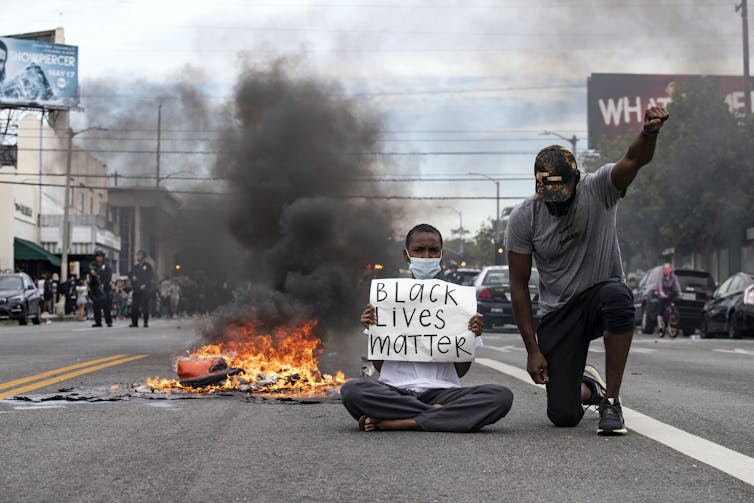
There is reason for hope
America enters the final months of the 2020 campaign in a state of despair and disrepair. The choice is between an opportunistic incumbent and a tin-eared challenger.
But the US has faced serious challenges before – and emerged stronger. Neither the civil war in the 19th century or the Spanish flu pandemic in the early 20th halted the extraordinary growth in power that followed both.
Moreover, the US constitution remains intact and federalism has undergone something of a rebirth since the start of the pandemic. And there is a new generation of younger, more diverse, national leaders being forged in the fire of crisis to help lead the recovery.
Timothy J. Lynch, Associate Professor in American Politics, University of Melbourne
This article is republished from The Conversation under a Creative Commons license. Read the original article.
The use and misuse of the Insurrection Act in the United States
Thursday, 04 June 2020 12:02 Written by theconversation 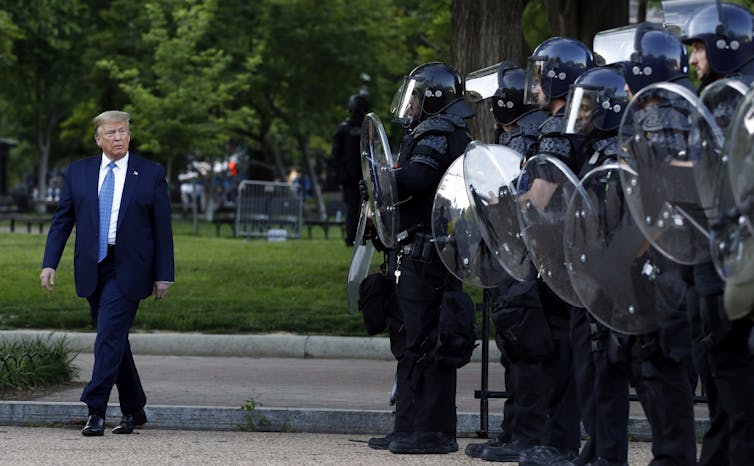
Jack L. Rozdilsky, York University, Canada and Heriberto Urby, Jr., Western Illinois University
In the wake of the killing of George Floyd, American cities are coping with strife and civil unrest comparable to 1968.
In an apparent attempt to divert attention from a lacklustre White House effort to counter the COVID-19 pandemic and a tone-deaf approach to racial injustice, President Donald Trump has entered into another of his many quagmires where he seems to have spoken first and contemplated later.
Despite Trump’s specious symbolic display involving clearing a park of protesters to pose to take photos in front of an empty church, the president’s words at his June 1 news conference were consequential.
He specifically named the Insurrection Act of 1807 as a possible remedy to the current crisis. Surprisingly, due to that obscure act, Trump may indeed have the power to send federal troops into states without a request from the governor, even as the Pentagon tries to distance itself from the threat.
Using military force domestically
In times of disaster, active-duty military troops can be ordered to perform actions to protect life, property and maintain order. In terms of U.S. federal legislation enabling the government to take action to respond to disaster, the Stafford Act authorizes the use of the military for disaster relief. In such cases, a state’s governor must make a request for the military to provide very specific support roles for disaster relief efforts.
However, in the American constitutional republic, there are direct limits on the support roles that the military can play in times of crisis.
Restrictions on the participation of the military in domestic law enforcement are interpreted through the Posse Comitatus Act. It’s been in force since 1878, when it was enacted as part of a backlash against the imposition of federal martial law in the former Confederate States during the post-Civil War Reconstruction era.
There are four statutory exceptions when the military can act in a domestic law enforcement capacity, in direct contradiction to the Posse Comitatus Act.
Three of the exceptions are based on enabling responses to contemporary threats to the United States, when only the federal government would be capable of mustering the resources necessary to respond to serious national security crises of grave concern.
Those situations pertain to fighting drug and transnational organized crime activities, assistance in the case of crimes involving nuclear material and emergency situations involving the use of weapons of mass destruction.
The Insurrection Act
The fourth exception is the Insurrection Act, which has had very little alteration since it was enacted on March 3, 1807.
The act permits the federal deployment of military force into the states to suppress insurrections and enforce federal law in three circumstances. These circumstances are clearly defined by the legislation.
Federal aid to state governments is the first circumstance that allows for federal military intervention to suppress an insurrection in a state, upon the request of that state’s governor or legislature.
During the 1992 Los Angeles riots, for example, President George H.W. Bush deployed federal troops at the request of the California governor to quell civil uprisings in south-central L.A.
Another section of the act, entitled “Use of Militia and Armed Forces to Enforce Federal Authority” permits the president, on his own initiative, to suppress rebellion or enforce federal laws. If the president believes that …
“Unlawful obstructions, combinations, assemblages, or rebellion against the authority of the United States make it impracticable to enforce the laws of the United States in any States by the ordinary course of judicial proceedings …”
… then armed forces of the federal government can be deployed to the states.
The origins for the domestic use of troops are found in the Calling Forth Act of 1792, which allowed for President George Washington to send federal to troops to suppress the Whiskey Rebellion despite disagreements with the governor of Pennsylvania.
The Calling Forth Act was extended into the 1807 Insurrection Act as the militia acts of the 1790s that first delegated sweeping emergency powers to the president expired.
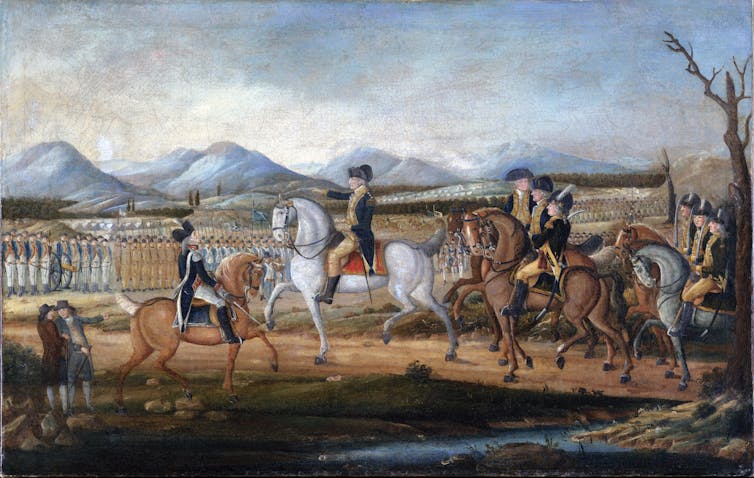
A section of the Insurrection Act entitled “Interference with States and Federal Law” allows for the president to take any measures necessary to suppress, in a state, any insurrection, domestic violence, unlawful combination or conspiracy.
The 1957 deployment of federal troops by President Dwight Eisenhower to enforce school desegregation orders in Little Rock, Ark., was an example of the use of that provision.
A divider-in-chief
While Trump has stopped short of invoking the 1807 act to use the military to enforce laws domestically, he’s kept the option open, fomenting further unrest and division.
Rather than staging photo opportunities while awkwardly holding a Bible in Lafayette Square, Trump would have issued a formal proclamation calling on the insurgents to disperse if he’s serious about the application of the Insurrection Act.

Section 334 of the Insurrection Act states:
“Whenever the President considers it necessary to use the militia or the armed forces under this chapter, he shall, by proclamation, immediately order the insurgents to disperse and retire peaceably to their abodes within a limited time.”
In the event that Trump issues a formal proclamation to disperse, we can then assume that he and his legal team are going down the path of sending federal military forces to the states, with or without the request or permission of governors.
Words we have heard and actions we have witnessed are not those of a commander-in-chief, but a divider who is ill-informed about the appropriate methods and uses of emergency powers available to the executive branch. We dare not believe that the Insurrection Act of 1807 was intended to be a national call to war against the American people.
Jack L. Rozdilsky, Associate Professor of Disaster and Emergency Management, York University, Canada and Heriberto Urby, Jr., Assistant Professor of Disaster and Emergency Management, Western Illinois University
This article is republished from The Conversation under a Creative Commons license. Read the original article.
After Philando Castile’s murderer walked free, would George Floyd’s killer Chauvin get jail time?
Wednesday, 03 June 2020 05:36 Written by face2faceafricaIn July of 2016, 32-year-old African-American Minnesota resident Philando Castile was driving his fiancée Diamond Reynolds and four-year-old daughter when he was stopped on the road by a St. Anthony officer, Jeronimo Yanez over a broken taillight.
Castile out of good fate informed the officer he had a license to carry a firearm, which he had on him. Yanez then asked to see his identification but when he attempted to retrieve it, Yanez fired seven bullets into the vehicle killing Castile. Yanez’s defense was that when Castile reached for his ID, he feared for his life believing he was reaching for his gun. Global citizens got to see a slumped Castile bleeding profusely from his gunshot wounds as his partner, Reynolds had the presence of mind to live stream the atrocity which had just happened.
The Black American community was hopeful that the Minnesota police officer would be charged for murder. There was talk Yanez faced a second-degree manslaughter charge which carried up to a 10-year prison term and a fine of $20,000.
However, when the trial ended on June 16, 2017, Yanez was found not guilty of second-
degree manslaughter by the majority white jury in addition to being acquitted of t
wo counts of intentional discharge of firearm that endangers safety.
Despite the wanton murder of Castile and Alton Sterling in Baton Rouge, Louisiana at the hands of racist police officers, which led to nationwide protests, the officers got to walk free.
With about 1,000 police shootings recorded each year in the United States, the history shows that a great deal of officers who are involved in such deaths such as Castile’s have the charges dropped or are acquitted with settlements reached with the affected families.
For officers to act professionally in discharging their duties, some have called for such settlement fees to be deducted from their pensions, as well as, face charges without getting shielded.
Meanwhile, Philando Castile’s uncle Clarence Castile speaking to the BBC in the wake of George Floyd’s murder also in Minnesota noted he felt the life drained out of Floyd’s body physically and emotionally. He stated the American police’s continuous use of excessive force was unacceptable, adding looting was equally not the way to go.
Since Minnesota police officer Derek M. Chauvin used the dangerous police tactic of kneeling on Floyd’s neck and killing him in the process, there has been a demand for him to be charged with murder. There has been six nights of protests across American states, demanding accountability that this should not be business as usual.
Nearly 40 states are under curfew to contain protest marches which in some locations have turned violent. As anger and frustration spills onto American streets in this coronavirus season and with a recorded 40 million job losses, it does appear what will assuage the wrath of the people is for Chauvin to face a murder charge having gone through due process and for the three other offices who were on guard during the attack on Floyd also penalized beyond getting fired at their police station.
For as is known too well, the American judicial system and police union influence which freed Jeronimo Yanez could as well free Chauvin, despite video evidence. Time will tell.
Police officers accused of brutal violence often have a history of complaints by citizens
Wednesday, 03 June 2020 01:16 Written by theconversation 
Jill McCorkel, Villanova University
As protests against police violence and racism continue in cities throughout the U.S., the public is learning that several of the officers involved in the killing of George Floyd in Minneapolis and Breonna Taylor in Louisville share a history of complaints by citizens of brutality or misconduct.
Decades of research on police shootings and brutality reveal that officers with a history of shooting civilians, for example, are much more likely to do so in the future compared to other officers.
A similar pattern holds for misconduct complaints. Officers who are the subject of previous civilian complaints – regardless of whether those complaints are for excessive force, verbal abuse or unlawful searches – pose a higher risk of engaging in serious misconduct in the future.
A study published in the American Economic Journal reviewed 50,000 allegations of officer misconduct in Chicago and found that officers with extensive complaint histories were disproportionately more likely to be named subjects in civil rights lawsuits with extensive claims and large settlement payouts.
In spite of this research, many law enforcement agencies not only fail to adequately investigate misconduct allegations, they rarely sustain citizen complaints. Disciplinary sanctions are few and reserved for the most egregious cases.
Complaints, lawsuits – but few consequences
Derek Chauvin, the ex-officer who has been charged with third-degree murder and second-degree manslaughter for killing Floyd, is no stranger to situations in which deadly force has been deployed.
During a 2006 roadside stop, Chauvin was among six officers who, in just four seconds, fired 43 rounds into a truck driven by a man wanted for questioning in a domestic assault. The man, Wayne Reyes, who police said aimed a sawed-off shotgun at them, died at the scene. The police department never acknowledged which officers had fired their guns and a grand jury convened by prosecutors did not indict any of the officers.
Chauvin is also the subject of at least 18 separate misconduct complaints and was involved in two additional shooting incidents. According to The Associated Press, 16 of the complaints were “closed with no discipline” and two letters of reprimand were issued for Chauvin related to the other cases.
Tou Thao, one of three Minneapolis officers at the scene as Floyd pleaded for his life, is named in a 2017 civil rights lawsuit against the department. Lamar Ferguson, the plaintiff, said he was walking home with his pregnant girlfriend when Thao and another officer stopped him without cause, handcuffed him and proceeded to kick, punch and knee him with such force that his teeth shattered.
The case was settled by the city for US$25,000, with the officers and the city declaring no liability, but it is not known if Thao was disciplined by the department.
In Louisville, Kentucky, at least three of the officers involved in the shooting death of Breonna Taylor while serving a no-knock warrant at her home – allowing them to use a battering ram to open her door – had previously been sanctioned for violating department policies.
One of the officers, Brett Hankison, is the subject of an ongoing lawsuit alleging, according to news reports, harassing suspects and planting drugs on them. He has denied the charges in a response to the lawsuit.
Another officer in the Taylor case, Myles Cosgrove, was sued for excessive force in 2006 by a man whom he shot seven times in the course of a routine traffic stop. The judge dismissed the case. Cosgrove had been put on paid administrative leave as his role in the shooting was investigated by his department, and returned to the department after the investigation closed.

Patterns of misconduct and abuse
I am a scholar of law and the criminal justice system. In
in Philadelphia, I regularly encounter patterns of police misconduct including witness intimidation, evidence tampering and coercion. It is often the same officers engaging in the same kinds of misconduct and abuse across multiple cases.The Bureau of Justice Statistics reports that across the nation fewer than one in 12 complaints of police misconduct result in any kind of disciplinary action.
And then there is the problem of “gypsy cops” – a derogatory ethnic slur used in law enforcement circles to refer to officers who are fired for serious misconduct from one department only to be rehired by another one.
Timothy Loehmann, the Cleveland officer who shot and killed 12-year-old Tamir Rice, resigned before he was fired from his previous department after they deemed him unfit to serve. A grand jury did not indict Loehmann for the killing, but he was fired by the Cleveland Division of Police after they found he had not disclosed the reason for leaving his previous job.
In the largest study of police hiring, researchers concluded that rehired officers, who make up roughly 3% of the police force, present a serious threat to communities because of their propensity to re-offend, if they had engaged in misconduct before.
These officers, wrote the study’s authors, “are more likely … to be fired from their next job or to receive a complaint for a ‘moral character violation.’”
The Newark model
The Obama administration’s Task Force on 21st Century Policing recommended the creation of a national database to identify officers whose law enforcement licenses were revoked due to misconduct. The database that currently exists, the National Decertification Index, is limited, given state level variation in reporting requirements and decertification processes.
Analysts agree that this is a useful step, but it does not address underlying organizational and institutional sources of violence, discrimination and misconduct.
For example, in the aftermath of the police shooting of Michael Brown in Ferguson, Missouri, the Department of Justice found that the department had a lengthy history of excessive force, unconstitutional stop and searches, racial discrimination and racial bias.
The report noted that the use of force was often punitive and retaliatory and that “the overwhelming majority of force – almost 90% – is used against African Americans.”
One promising solution might be the creation of independent civilian review boards that are able to conduct their own investigations and impose disciplinary measures.
In Newark, New Jersey, the board can issue subpoenas, hold hearings and investigate misconduct.
Research at the national level suggests that jurisdictions with citizen review boards uphold more excessive force complaints than jurisdictions that rely on internal mechanisms.
But historically, the work of civilian review boards has been undercut by limitations on resources and authority. Promising models, including the one in Newark, are frequently the target of lawsuits and harassment by police unions, who say that such boards undermine the police department’s internal disciplinary procedures.
In the case of civilian review board in the Newark, the board largely prevailed in the aftermath of the police union lawsuit. The court ruling restored the board’s ability to investigate police misconduct – but it made the board’s disciplinary recommendations nonbinding.
[Deep knowledge, daily. Sign up for The Conversation’s newsletter.]
Jill McCorkel, Professor of Sociology and Criminology, Villanova University
This article is republished from The Conversation under a Creative Commons license. Read the original article.


